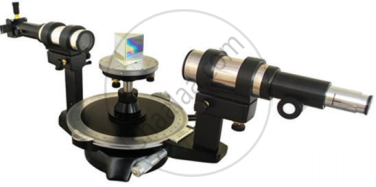Advertisements
Advertisements
प्रश्न
Mention different parts of the spectrometer.
उत्तर
The spectrometer is an optical instrument used to study the spectra of different sources of light and to measure the refractive indices of materials. It is shown in following figure.

Spectrome
It consists of basically three parts. They are
- collimator
- prism table and
- Telescope.
- Collimator:
- The collimator is an arrangement to produce a parallel beam of light. It consists of a long cylindrical tube with a convex lens at the inner end and a vertical slit at the outer end of the tube.
- The distance between the slit and the lens can be adjusted such that the slit is at the focus of the lens. The slit is kept facing the source of light.
- The width of the slit can be adjusted. The collimator is rigidly fixed to the base of the instrument.
- Prism table:
- The prism table is used for mounting the prism, grating etc. It consists of two circular metal discs provided with three levelling screws.
- 2. It can be rotated about a vertical axis passing through its centre and its position can be read with verniers V1 and V2. The prism table can be raised or lowered and can be fixed at any desired height.
- Telescope:
- The telescope is an astronomical type. It consists of an eyepiece provided with cross wires at one end and an objective lens at its other end.
- The distance between the objective lens and the eyepiece can be adjusted so that the telescope forms a clear image at the cross wires when a parallel beam from the collimator is incident on it.
- The telescope is attached to an arm that is capable of rotation about the same vertical axis as the prism table. A circular scale graduated in a half degree is attached to it.
- Both the telescope and prism table is provided with radial screws for fixing them in the desired position and tangential screws for fine adjustments.
APPEARS IN
संबंधित प्रश्न
Answer the following question in detail.
Derive an expression for the magnifying power of a simple microscope. Obtain its minimum and maximum values in terms of its focal length.
Answer the following question in detail.
What is a terrestrial telescope and an astronomical telescope?
What is the near point focusing?
What is the use of collimator in a spectrmeter?
Discuss about simple microscope and obtain the equations for magnification for near point focusing and normal focusing.
Obtain the equation for resolving the power of the microscope.
A compound microscope has a magnifying power of 100 when the image is formed at infinity. The objective has a focal length of 0.5 cm and the tube length is 6.5 cm. What is the focal length of the eyepiece.
The near point and the far point for a person are 50 cm and 500 cm, respectively. Calculate the power of the lens the person should wear to read a book held in hand at 25 cm. What maximum distance is clearly visible for the person with this lens on the eye?
There are four convex lenses L1, L2, L3 and L4 of focal length 2, 4, 6 and 8 cm, respectively. Two of these lenses from a telescope of length 10 cm and magnifying power 4. The objective and eye lenses are respectively
When a convex lens of 12.5 cm focal length is used as a magnifying glass, normal eye can see an object clearly at a distance of 25 cm. The magnifying power of the instrument is ____________.
The magnifying power of a telescope is high if its objective and eyepiece have respectively ______.
The speed of light in media 'A' and 'B' are 2.0 × 1010 cm/s and 1.5 × 1010 cm/s respectively. A ray of light enters from medium B to A at an incident angle 'θ'. If the ray suffers total internal reflection, then ______.
An object viewed from a near point distance of 25 cm, using a microscopic lens with magnification '6', gives an unresolved image. A resolved image is observed at infinite distance with a total magnification double the earlier using an eyepiece along with the given lens and a tube of length 0.6 m, if the focal length of the eyepiece is equal to ______ cm.
An observer looks at a distant tree of height 10 m with a telescope of magnifying power of 20. To the observer the tree appears:
The image formed by an objective of a compound microscope is ______.
A camera objective has an aperture diameter of d. If the aperture is reduced to diameter d/2, the exposure time under identical conditions of light should be made ______.
